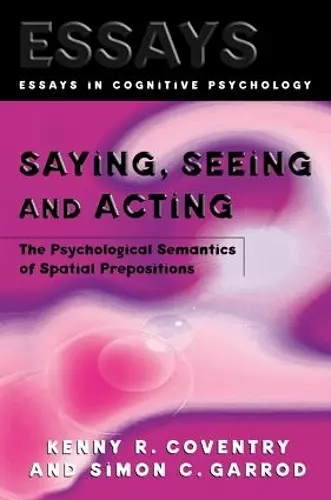Saying, Seeing and Acting
The Psychological Semantics of Spatial Prepositions
Kenny R Coventry author Simon C Garrod author
Format:Hardback
Publisher:Taylor & Francis Ltd
Published:5th Feb '04
Currently unavailable, and unfortunately no date known when it will be back
This hardback is available in another edition too:
- Paperback£55.99(9781138877351)

Our use of spatial prepositions carries an implicit understanding of the functional relationships both between objects themselves and human interaction with those objects.
This is the thesis rigorously explicated in Saying, Seeing and Acting. It aims to account not only for our theoretical comprehension of spatial relations but our ability to intercede with efficacy in the world of spatially related objects. Only the phenomenon of functionality can adequately account for what even the simplest of everyday experiences show to be the technically problematic, but still meaningful status of expressions of spatial location in contentious cases.
The terms of the debate are established and contextualised in Part One. In the Second Section, systematic experimental evidence is drawn upon to demonstrate specific covariances between spatial world and spatial language. The authors go on to give an original account of the functional and geometric constraints on which comprehension and human action among spatially related objects is based. Part Three looks at the interaction of these constraints to create a truly dynamic functional geometric framework for the meaningful use of spatial prepositions.
Fascinating to anyone whose work touches on psycholinguistics, this book represents a thorough and incisive contribution to debates in the cognitive psychology of language.
It has increasingly become clear that functional information is necessary in addition to geometric information in explaining spatial semantics, and this book provides an excellent synthesis of developments in the literature. The authors point out that while early accounts are untenable due to their heavy reliance on geometry, more recent accounts too often merely catalogue the flaws of these systems, and do not clearly describe alternative systems that could generate a wide variety of behaviours with relatively little machinery. The authors' notion of location control is compelling in that it appears to address the concerns of recent work with the simplicity found in earlier geometry accounts. I found it a pleasure to read. - Ed Munnich, University of California, Berkeley
This book nicely covers a wide scattering of ideas that have appeared in the literature over a great number of years, pulling them all together into a unified account. - Laura Carlson, University of Notre Dame
ISBN: 9781841691169
Dimensions: unknown
Weight: 560g
214 pages